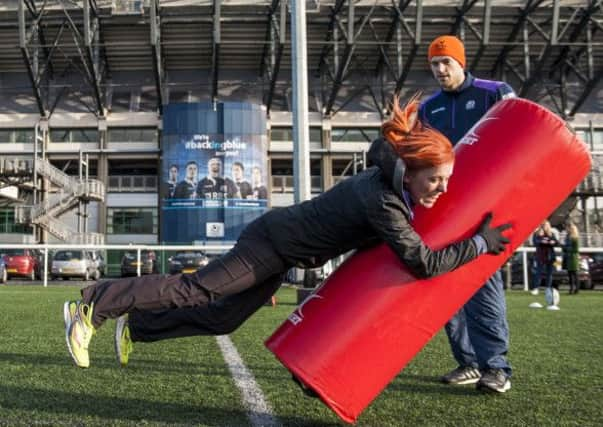A training session with Scotland’s rugby team


Two broken nails and a sore shoulder. As injuries go, I shouldn’t complain, considering my team mate for the afternoon, Tim Visser, is recovering from a broken leg, sustained during a nasty tackle on the rugby pitch. The Scotland winger has been out of action since October and has missed out on selection for this weekend’s Six Nations squad as a result.
“I got tackled low then someone else tackled me high the other way,” he says, “so my leg broke. That’s just the sheer force of rugby.”
Advertisement
Hide AdWhich is when I start to rethink the wisdom of accepting an invitation to train with the team. It starts gently with a bit of throwing and running, throwing and running, over and over. And catching too. The boys say I have “good hands” which pleases me no end.
They teach me to tackle, aiming my shoulder low, head in, back straight – thump – before getting up to do it again. First one shoulder, then the next. It doesn’t hurt much... until the next morning.
Then we move on to a tackling a moving target – a giant padded Polo mint. After more running and catching and scoring of tries, I have to put it all together in one seamless series of movements. The boys are very encouraging. I growl a lot, assuming this is what rugby boys do. (They don’t.)
After about 45 minutes I’m glowing, but the boys have barely broken a sweat. It’s all in an afternoon’s work, I guess, when training is a full-time job. “If there’s a game on a Friday we train hard on a Monday and Tuesday with weights and rugby,” explains prop Alasdair Dickinson. “We’ll usually have Wednesday off, then rugby training on Thursday. We’ll have a recovery session on a Saturday after the match, with lots of stretching.”
For Visser, the schedule is a little different. “Because I’ve been injured, I do most of my training in the morning: upper body weights three times a week. I can’t do my lower body because of my leg. I’m in at 8am, then I have physiotherapy and rehab. I’ll be done by 11am most days.”
Injuries are an occupational hazard when you’re throwing yourself at 18 stone obstacles. “There are the actual physical rugby accidents, which is what I had,” says Visser. “You can get tackled in the wrong way, or step in the wrong way and something tears off. The other ones are wear and tear – joints are normally the first things to go. And not just with the older players. Some of the younger players come in and their ankles go or they get a torn ligament and it won’t heal properly so they can’t come back from it. Shoulders are a big one too.”
Advertisement
Hide Ad“Nowadays, all the players are bigger, faster, stronger,” says Dickinson, “so the collisions are much harder. Your body takes a bit of a beating. Rugby is a whole-body sport. It’s not like football where ankles and knees and hamstring are the main injuries; in rugby you’re using your whole body, from head all the way down to ‘turf toe’.”
Turf toe, explains Visser for the rugby initiate, is a joint inflammation in the toe and is a common injury among props.
Advertisement
Hide AdSo while training is still about getting bigger, faster and stronger, it’s also heavily focused on injury prevention. “We do a lot of prehab,” says Visser. “Before most gym sessions we’ll have a general range of exercises to strengthen specific areas. We’ll do shoulder exercises to strengthen the back of the shoulder joint and the rotator cuff; for the knee and ankle we do a lot of balance stuff on the wobble board.”
“I turned pro ten years ago,” says Dickinson, “and the difference between then and now in terms of sports science is massive. To begin with it was all, ‘Do more, you’ll get better’, whereas now, at certain times, less is more, especially when you’re playing every week. There’s only so much you can do physically without breaking.”
The introduction of GPS technology helps ensure players aren’t over-training – or doing too little. It’s like a highly evolved Nike Plus module in the back of players’ necks which tracks how many metres they run and how fast they’re going during each session. “You’ll see a sort of bubble at the back of their necks during games,” says Dickinson, “it’s like a microchip.”
But sometimes you simply can’t avoid the freak accidents. “In the summer we were playing South Africa,” says Visser, “and Peter Horne was just sprinting but he stepped badly and injured his knee. I guess luck is a pretty large part of it.”
So good luck tomorrow, guys. You know where I am if you need me.
Scotland play Ireland in the Six Nations tomorrow and England at Murrayfield next Saturday, 8 February, www.scottishrugby.org